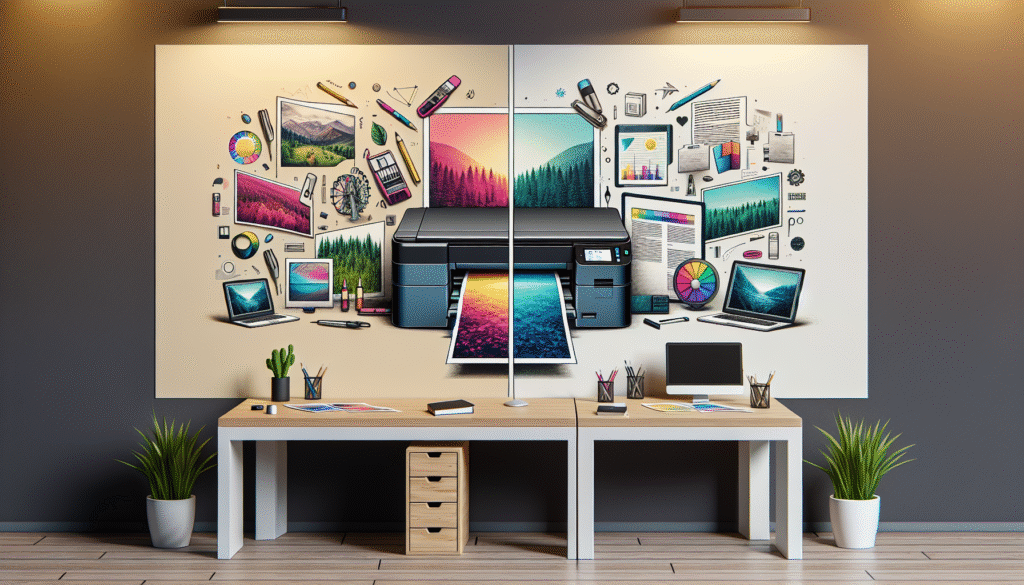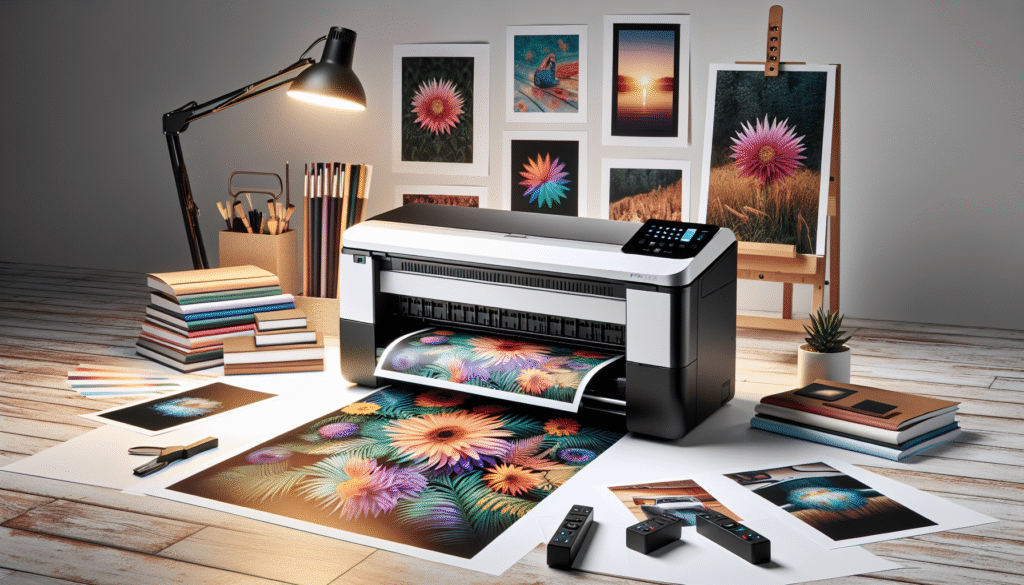Have you ever found yourself standing in front of a printer aisle, feeling like you’re on the precipice of a grand decision—one that will define the quality of your printed documents or cherished photographs for years to come? Choosing between dye-sublimation and laser printers is like choosing between two homes. Each one promises durability, efficiency, and happiness, but only one can reside in our hearts and on our desks.
In this article, we’ll walk through the functionalities, advantages, and potential drawbacks of dye-sublimation and laser printers. By the end, the goal is for us all to feel a sense of clarity, akin to a crisp, recently printed page. Just as we embark on any grand decision, we must first gather our tools of information.

What is Dye-Sublimation Printing?
Imagine being able to wave a magic wand and transform your cherished digital photos into glossy, rich prints that jump off the paper with vibrancy. This is essentially what dye-sublimation printing offers. But instead of a wand, we’re using heat to weave our spell.
The Mechanics of Dye-Sublimation
Dye-sublimation is a process that employs heat to transfer dye onto materials such as plastic, card, paper, or fabric. The term “sublimation” refers to the transition of the dye between the solid and gas states, skipping the liquid phase—a clever trick that plays out as the print cycle heats special ribbons containing the dye. The heat causes the dye to permeate the surface of the printing medium, solidifying as a durable and continuous tone once cooled.
The Vibrancy of Dye-Sublimation
Have you ever gazed at a scenic photograph, where colors seem to sing and swim, as though life itself is captured on a single piece of glossy paper? Dye-sublimation prints excel in reproducing such quality, offering smoother gradations and rich hues that are ideal for photographic prints.
Dye-Sublimation in Our Daily Lives
From printing family photos to creating professional-grade graphics, dye-sublimation has a versatile range of applications. We might find ourselves using this method for personalized gifts, custom apparel, or even our home decor. Its adaptability makes it a beloved tool for creative souls.
What is Laser Printing?
In the ring corner opposite dye-sublimation, we find the laser printer—an industrious machine known for its speed and sharpness. For those of us who value efficiency, reliability, and that crisp text, the laser printer has always been a champion in the office and at home.
The Laser Printing Process
Think of laser printing as an orchestration, one where precise movements and fine materials choreograph to create documents with impeccable alignment and clarity. The process involves a laser beam that projects an image of the desired document onto an electrically charged drum. Powdered ink, or toner, adheres to the areas charged by the laser, and the result is transferred to paper through a combination of pressure and heat.
Precision and Speed of Laser Printers
For any of us who ever spent hours staring at an ink drying, fanning the paper like we’re offering a polite round of applause, the speed of laser printers serves as a revelation. They deliver swift print jobs, particularly in monochrome, and do so with remarkable precision.
Uses of Laser Printers in Our World
From the humdrum of printing memos and reports in our workplaces to creating labels and handouts at home, laser printers are the unsung heroes of efficient and affordable print tasks. They specialize in handling high-volume print needs where reliability and longevity are valued over photographic perfection.

Comparing Key Features: Dye-Sublimation vs Laser Printers
Now, let’s dive deeper into the points of comparison that illuminate the key differences between these printer types. Whether it is the weighty substantiality of the laser printer or the aesthetic magic of dye-sublimation that captures our fancy, examining these criteria will help solidify our judgments.
Color Quality and Resolution
| Feature | Dye-Sublimation | Laser Printers |
|---|---|---|
| Color Quality | Superior color blending and realistic images | High-quality, vibrant text and graphics (less photographic) |
| Resolution | Excellent for smooth gradients | Best for sharp text and line precision |
When we consider color printing, dye-sublimation tends to excel where imagery comes with nuances of shading and tone. On the other hand, when we need razor-sharp text or graphics, laser printers can perform exceptionally well with vibrant energy.
Printing Speed and Volume
| Feature | Dye-Sublimation | Laser Printers |
|---|---|---|
| Printing Speed | Generally slower | Faster, especially for documents |
| Volume Capacity | Lower throughput, designed for quality | High-capacity, built for quantity |
Dye-sublimation can be likened to a discerning artist who meticulously crafts each masterpiece, whereas laser printers are more akin to a factory line, maximizing output and efficacy.
Cost Considerations
| Feature | Dye-Sublimation | Laser Printers |
|---|---|---|
| Initial Cost | Generally higher printer cost | Often lower initial printer cost |
| Cost per Print | Higher per print due to materials | More cost-effective in bulk printing |
While upfront cost and materials may lead us to see dye-sublimation as a pricer alternative, the satisfaction of photo-quality prints offsets this for specialized applications. For regular document needs, laser printers provide a cost-effective solution.
The Pros and Cons: A Balancing Act
Just like every story has two sides, so does our comparison of these printer types. Understanding the pros and cons helps us in making well-rounded decisions that suit our individual printing needs.
Advantages of Dye-Sublimation Printers
- Photographic Quality: Sublime quality for printing photographs and graphics.
- Durability: Prints are less susceptible to smudging and have longevity.
- Aesthetic Appeal: Ideal for creative projects with diverse materials.
Disadvantages of Dye-Sublimation Printers
- Slower Printing Speed: Patience is required for high-quality outputs.
- Higher Costs: Competitive pricing, particularly for consumables.
- Limited Capacity: Not suited for large-volume printing tasks.
Advantages of Laser Printers
- Speed and Efficiency: Fast printing of text-heavy documents.
- Cost-Effective: Economically viable for high-volume tasks.
- Precision: Exceptional for text and simple graphics.
Disadvantages of Laser Printers
- Limited Color Range: Not ideal for high-fidelity photo printing.
- Initial Learning Curve: Setup can be more complex.
- Toner Smudging: Though rare, can occur post-printing.
Where Do We Go From Here: Making the Right Choice
After wading through terms and mechanics, features, and figures, we arrive at the crossroads. Yet, each path has its appeal, ready to accommodate our needs, whether they lie in the beauty of a cherished photo or the efficiency of business output.
Ideal Users for Dye-Sublimation Printers
If we find ourselves in the arena of photography, design, or individualized art projects, dye-sublimation printers tend to perfectly align with our hearts and projects. Someone creating vivid prints for their gallery or crafting memorable keepsakes will find it as indispensable as a painter finds their brush.
Ideal Users for Laser Printers
Office goers, students, and administration teams who need tasks completed expediently and affordably will find a steadfast ally in the humble laser printer. Those whose days are filled with endless print tasks—be it forms, theses, or manuals—will appreciate the swift reliability of this trusty machine.
Thinking Ahead: Future Innovations and Trends
As much as we detail and deconstruct the current landscape of printers, it’s the unknown future that holds both excitement and possibility. We’re living in an evolving digital world where advancements beckon at every turn.
Emerging Technology in Printing
Recent conversations nod toward 3D printing’s potential to unlock new capabilities in standard ink technologies, whispering promises like personalized ink formulations and embedded technology for added dimensions in prints.
Evolving User Needs
As our lives become more digital, so too will our needs for connecting our devices effortlessly to our printers. We anticipate even more robust wireless connectivity and app integrations that will allow our creativity to extend far beyond current limitations.
Final Thoughts
There’s something inherently satisfying in knowing that we’ve explored these avenues together, weighing options and understanding the mechanics of the devices that will accompany us in our endeavours. As much as it is a technical decision, it’s also about how a printer fits into our lives and aligns with our personal and professional pursuits.
Our foray into the world of dye-sublimation and laser printers may have posed more questions as much as it answered them, but that’s perfectly okay. We now stand more informed and more inspired to make a choice that will sit happily in our home or office corner, ready to translate digital pages into tangible creations—be it with vibrant hues or sharp, elegant text.
